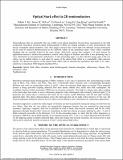Optical Stark effect in 2D semiconductors
Author(s)
McIver, James W.; Lee, Yi-Hsien; Sie, Edbert Jarvis; Fu, Liang; Kong, Jing; Gedik, Nuh; ... Show more Show less
DownloadOptical stark effect.pdf (1.674Mb)
PUBLISHER_POLICY
Publisher Policy
Article is made available in accordance with the publisher's policy and may be subject to US copyright law. Please refer to the publisher's site for terms of use.
Terms of use
Metadata
Show full item recordAbstract
Semiconductors that are atomically thin can exhibit novel optical properties beyond those encountered in the bulk compounds. Monolayer transition-metal dichalcogenides (TMDs) are leading examples of such semiconductors that possess remarkable optical properties. They obey unique selection rules where light with different circular polarization can be used for selective photoexcitation at two different valleys in the momentum space. These valleys constitute bandgaps that are normally locked in the same energy. Selectively varying their energies is of great interest for applications because it unlocks the potential to control valley degree of freedom, and offers a new promising way to carry information in next-generation valleytronics. In this proceeding paper, we show that the energy gaps at the two valleys can be shifted relative to each other by means of the optical Stark effect in a controllable valley-selective manner. We discuss the physics of the optical Stark effect, and we describe the mechanism that leads to its valleyselectivity in monolayer TMD tungsten disulfide (WS[subscript 2]).
Date issued
2017-04Department
Massachusetts Institute of Technology. Department of Electrical Engineering and Computer Science; Massachusetts Institute of Technology. Department of PhysicsJournal
Proceedings of SPIE--the Society of Photo-Optical Instrumentation Engineers
Publisher
SPIE
Citation
Sie, Edbert J.; McIver, James W.; Lee, Yi-Hsien; Fu, Liang; Kong, Jing and Gedik, Nuh. “Optical Stark Effect in 2D Semiconductors.” Edited by Michael K. Rafailov and Eric Mazur. Ultrafast Bandgap Photonics (May 13, 2016). © 2016 SPIE
Version: Final published version
ISSN
0277-786X
1996-756x